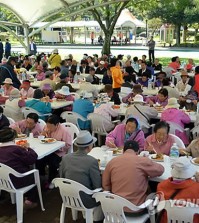- California Assembly OKs highest minimum wage in nation
- S. Korea unveils first graphic cigarette warnings
- US joins with South Korea, Japan in bid to deter North Korea
- LPGA golfer Chun In-gee finally back in action
- S. Korea won’t be top seed in final World Cup qualification round
- US men’s soccer misses 2nd straight Olympics
- US back on track in qualifying with 4-0 win over Guatemala
- High-intensity workout injuries spawn cottage industry
- CDC expands range of Zika mosquitoes into parts of Northeast
- Who knew? ‘The Walking Dead’ is helping families connect
Births of multicultural children up 4.1% in 2012
By Kim Rahn
The birthrate of multiracial children is increasing at a higher rate than those from Korean couples, according to the latest data.
Statistics Korea said 22,908 children were born to multiracial couples in 2012, up 4.1 percent from the previous year’s 22,014.
That was a higher growth rate than that of children born to Korean parents, which stood at 2.7 percent.
Multiracial children accounted for 4.7 percent of the total number of births.
When it comes to multiracial births, the ratios of second and third children increased, while that of firstborns decreased.
The average age of mothers was 28.5, up 0.31 years. While the rate for those in their early 20s declined last year, that for people in their late 20s and early 30s increased.
Nearly 83 percent of the fathers were Korean, followed by Chinese, 5.2 percent, and American, 3.7 percent. The rate of native Korean fathers has been on the decline.
When it comes to mothers’ nationalities, Vietnamese accounted for 34.6 percent, followed by Chinese, 25.6 percent, and Korean, 13.2 percent. While the rates for mothers from Vietnam, China and the Philippines have declined, that of Korean mothers has been rising.
Contrary to the growing number of multiracial children, the number of interracial marriages has been declining.
In 2012, 29,224 multiracial couples tied the knot, down 4.8 percent from the previous year.
This was a larger drop than the marriages between Korean nationals, which saw a 0.2-percent decrease from a year before.
The number of multiracial marriages has been on the decline from 35,098 in 2010 to 30,695 in 2011 and to less than 30,000 last year.
Consequently, the ratio of interracial marriages among the nation’s total marriages dropped from 10.8 percent in 2010 to 9.3 percent in 2011 and 8.9 percent in 2012.
“We presume interracial marriages have dropped as the government has tightened regulation on such marriages following problems that have arisen from illegal matchmaking agencies’ operations, or marriages that took place without enough information about the would-be spouses,” an official of the statistics agency said.
The government has applied stricter rules to the issuance of marriage visas, cracked down on matchmaking companies’ illegal operations and required that Korean spouses attend lectures on cultural sensitivity.
Marriages between Korean men and foreign women have decreased, while those between foreign men and Korean women have risen.
Men married at the age of 36 on average, a drop from 36.5 in 2010 and 36.1 in 2011, while women did so at 26.9, an increase from 26.2 in 2010 and 26.6 in 2011.
By nationality, 71 percent of husbands were Korean, followed by Chinese, 9.2 percent; American, 5.5 percent; and Japanese, 5.4 percent. For wives, Chinese accounted for 29.9 percent, followed by Vietnamese, 23.2 percent; Korean, 22.2 percent; and Filipina, 7.8 percent.
Last year, 13,701 multiracial couples divorced, 5.2 percent down from a year before. Divorces among Korean couples increased 0.8 percent.
Divorces between Korean men and foreign women have declined, while those between foreign men and Korean women have risen.










![Korean-American Shin Eun-mi, 53, holds a press conference Tuesday in central Seoul, where she lashed out at conservative media outlets. [NEWSIS]](http://www.koreatimesus.com/wp-content/uploads/2014/12/Eun-Mi-Shin-199x223.jpg)




